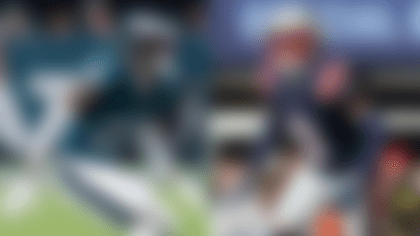NFL coaches are going for it on fourth down, when the numbers say they should, at a higher rate than ever before, according to the Next Gen Stats Decision Guide powered by AWS.
Through the first nine weeks of the 2021 season, there have been 268 fourth-down situations in which the model suggested going for it was the optimal decision by two-plus percentage points in expected win probability value for the offense. Collectively, teams have kept the offense on the field in 147 of those situations. That equals a 55 percent optimal decision rate, which is a six-year high in the Next Gen Stats era (since 2016).
Every week this season, we have broken down the fourth-down and two-point conversion decisions that directly affect the outcome of games. With nine weeks of data, we can do more than break down decisions in silos -- we can now start to paint a picture of the numbers in aggregate.
Introducing, the Next Gen Stats Decision Guide midseason superlatives:
Most optimal decision-maker when the numbers say go for it

Optimal fourth-down decision percentage: 92% (12 of 13 strong go for it opportunities)
Armed with one of the NFL's deepest analytics departments, second-year head coach Kevin Stefanski is well-prepared to make the right call when it comes to fourth-down decisions. No coach correlates more with the NGS model than Stefanski -- which holds true in back-to-back seasons. Through the first nine weeks of the 2021 season, Stefanski and Co. have correctly gone for it -- when they should -- in 12 of 13 opportunities. At 92 percent, that's the highest rate among any coach by a significant margin. This comes a year after the Browns led the league by the same metric (79 percent, 11 of 14 strong go for it opportunities in 2020).
While Stefanski and his staff have gotten the process right, it has been the outcome that has not gone in the team’s direction through the first half of the season. The offense has converted on just seven of 18 fourth-down attempts, a 38.9 percent conversion rate (23rd in the NFL).
Stefanski’s most optimal game of the season came in Week 5 against the second-ranked coach by this metric, Brandon Staley of the Chargers (10-of-14, 71 percent). The teams combined to go 13 for 13 on fourth-down decisions (eight by Stefanski, five by Staley) that affected the team's chances of winning by at least one percent.
Most win probability value lost on suboptimal fourth-down decisions

Combined win probability percentage points lost on suboptimal fourth-down decisions: -0.41 wins
Sean McVay and Matthew Stafford form one of the strongest coach-quarterback duos in the NFL, and yet, McVay and Co. still opt for a conservative approach on fourth down. Entering the season, McVay was the third-most conservative head coach from 2018 to 2020 in our preseason decision-makers article, and this season has been no different. The Rams have lost -0.41 total percentage points in win probability value as a result of 24 suboptimal decisions (nine of which were suboptimal by two-plus percentage points).
McVay has been particularly conservative in the red zone, getting only two out of seven decisions inside the opponent's 20-yard line correct (in situations when the numbers say to go for it by at least one percentage point).
Most consequential decision: Lamar Jackson converts vs. Chiefs (Week 2)

FOURTH QUARTER: With 1:05 remaining and the Ravens (leading 36-35) facing a fourth-and-1 from their own 43-yard line, Baltimore's Lamar Jackson rushes for 2 yards, earning a new set of downs.
NGS Decision Guide recommendation: Go for it, by 22.6%
John Harbaugh’s decision to keep Jackson on the field on fourth-and-1 from the Ravens' 43-yard line was unequivocally the right call. So much so that the decision goes down as the strongest go for it recommendation over the last two seasons when a team was in a tie game or had the lead. The decision to go for it in this game helped the Ravens’ chances of winning by 22.6 percentage points more than if they had punted.
Harbaugh, with reassurance from Jackson, knew the more optimal decision was to go for it on fourth-and-1.3 yards (by our tracking data) -- a 76 percent proposition -- rather than giving the ball back to Patrick Mahomes and the Chiefs' offense, equating to roughly a 58 percent chance of winning the game from the Ravens' perspective. And while a fourth-down failure would have decreased the Ravens' win probability to 33 percent, Harbaugh and his team knew the risk was worth the reward. Having Jackson as your quarterback, especially in short-yardage situations, makes this even more of a slam-dunk decision.
Most suboptimal decision: 57-yard FG attempt vs. Packers (Week 5)

FOURTH QUARTER: With 26 seconds remaining and the Bengals (tied 22-22) facing a fourth-and-2 from the Packers' 39-yard line, Cincinnati's Evan McPherson misses a 57-yard field-goal attempt.
NGS Decision Guide recommendation: Go for it, by 10.4%
The first half of the season’s most suboptimal decision occurred at the end of a Packers-Bengals Week 5 matchup filled with missed kicks. The decision to kick instead of going for it was the suboptimal decision by 10.4 percentage points in win probability value. The odds the rookie kicker was expected to make the 57-yard kick? Forty percent. Conversely, if the Bengals had gone for it, the offense was looking at 55 percent odds.
McPherson missed the kick, giving the Packers an opportunity to kick the potential game-winning field goal as time expired, but Mason Crosby missed anyway. Over the final three minutes of the fourth quarter, and into overtime, the two kickers combined to miss five field goals (three by Crosby, two by McPherson) in what was a historic kicking day across the league. Crosby would go on to make his last kick of the day, a 49-yard game-winner at the two-minute mark in overtime.
Most optimal decision-maker in no-man's land

Optimal fourth-down decision percentage between the 40-yard lines: 67% (six of nine decisions)
Taylor may have objectively made the worst fourth-down decision of the first half of the 2021 regular season. But he’s been highly effective at identifying when to go for it in the area where coaches have difficulty deciding whether to keep the offense on the field or punt this year: between their own 40-yard line and the opponent’s 40-yard line. The Bengals have correctly gone for it six times between the 40-yard lines this season, twice more than any other team. Taylor’s optimal decision percentage in no man's land is 66.7 percent (six correct of nine opportunities).
Most optimal decision-maker when the numbers say go for it in own territory

Optimal fourth-down decision percentage in own territory: 75% (three of four strong go for it opportunities)
Keeping the offense on the field on fourth down in your own territory is commonly construed as a risky move. An unsuccessful play can have a drastic effect on a team’s chances to win, but sometimes, the numbers suggest going for it is the optimal decision. No coach has been better at it than Chargers head man Brandon Staley. The first-year coach has embraced analytics -- fourth-down decision-making, in particular -- going for it on three of four attempts in strong go for it situations when in his own territory (75 percent, highest of any team). If it weren’t for Stefanski’s near-perfect start on fourth down (12 of 13, 92 percent), Staley and Co. could be more relevant in the talks for most optimal decision-maker (10-of-14, 71 percent, tied for second-highest in the NFL, with Vic Fangio and the Broncos).
Most optimal in short-yardage situations



Optimal fourth-down decision percentage when the numbers say go for it with less than 1.5 yards to go: 100% (all three teams are 6-for-6)
Three coaches -- John Harbaugh, Dan Campbell and Sean Payton -- have gotten every short-yardage, go for it call correct through the first half of the season, according to the NGS Decision Guide. All three coaches have correctly gone for it on fourth down with less than 1.5 yards to go on all six of their respective go for it recommendations. Seeing Harbaugh here is no surprise with how aggressive the Ravens have been on fourth down in recent seasons. But it is somewhat surprising to see Payton (eight of 13 optimal decision percent in short-yardage situations in 2020) and Campbell embrace going for it. I suppose when you lose your franchise quarterback to retirement or are in a complete rebuild, you embrace a high variance of outcomes more often.
Decision to go for two down eight points

Number of times the Eagles went for two down eight points: Two (rest of NFL: two)
Dating back to the Doug Pederson era, the Eagles have been maestros at going for two when down eight points. The idea is driven by second-order logic -- the team is originally down by two scores, and therefore, must score at least two more times to win the game. If they go for two points and convert, the team can score one more touchdown, keep the opponent from scoring any points, and win the game with a touchdown and extra point. If the conversion attempt fails, the team will have to go for two again to tie the game (down eight).
The proverbial torch has been passed to Nick Sirianni and his staff. The Eagles have accounted for two of the four such situations this season (out of 24 total situations when a team scored a touchdown, leaving it down eight points). Since 2017, the Eagles have accounted for six of the 17 situations where a team went for two down eight points. No other team has done it more than twice (the Lions under Matt Patricia in Week 11, 2019 and Week 4, 2020).
Follow the Next Gen Stats team on Twitter.












